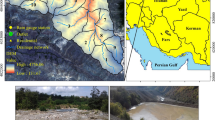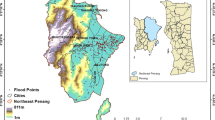Abstract
Floods are one of the most dangerous natural disasters that humanity has ever faced. In this study, a modified version of D number technique as a suitable form of multi-criteria decision-making (MCDM) approaches was proposed to prioritize flooding in the Sad-Kalan watershed of Iran using some flood related criteria. The proposed method can overcome some shortcomings and uncertainties of the existing MCDM methods. In order to evaluate the performance of the method regarding flood prioritization, its results were compared with the analytic hierarchy process (AHP) technique as mostly frequently used MCDM method. The findings demonstrate that the modified version of D number method provides better results than AHP method. In spite of inherent advantages of D number method, the advantages of the proposed method in relation to existing MCDM are as follows: 1- considering the local and global importance of used criteria, 2- reducing the uncertainty in decision makers’ judgments using employing the concept of Picture fuzzy-AHP, 3- considering the degree of consistency in evaluation of decision makers into calculations. Furthermore, the method is flexible and can be used in any region of the world.




Similar content being viewed by others
Availability of data and materials
The data that support the findings of this study are available from the first author, upon reasonable request.
Abbreviations
- MCDM:
-
Multi-criteria decision-making
- AHP:
-
Analytic hierarchy process
- EN:
-
Entropy of drainage network
- TCI:
-
Topographic control index
- SPI:
-
Stream power index
- TWI:
-
Topographic wetness index
- Cc:
-
Compactness coefficient
- DEM:
-
Digital elevation model
- CR:
-
Consistency ratio
- RI:
-
Random index
- CI:
-
Consistency index
- PFNs:
-
Picture fuzzy numbers
- PFWG:
-
PF weighted geometric mean
- PF:
-
Picture fuzzy
- PFAHP:
-
Picture fuzzy‑analytic hierarchy process
- SC:
-
Score
- AC:
-
Accuracy
References
Ahmadisharaf E, Kalyanapu AJ, Chung E-S (2016) Spatial probabilistic multi-criteria decision making for assessment of flood management alternatives. J Hydrol 533:365–378
Akay H, Baduna Koçyiğit M (2020) Flash flood potential prioritization of sub-basins in an ungauged basin in Turkey using traditional multi-criteria decision-making methods. Soft Comput 24:14251–14263
Akbari M, Meshram SG, Krishna R, Pradhan B, Shadeed S, Khedher KM, Sepehri M, Ildoromi AR, Alimerzaei F, Darabi F (2021) Identification of the groundwater potential recharge zones using MCDM models: full consistency method (FUCOM), best worst method (BWM) and analytic hierarchy process (AHP). Water Resour Manag 35(14):4727–4745
Barman BK, Rao CUB, Rao KS, Patel A, Kushwaha K, Singh SK (2021) Geomorphic analysis, morphometric-based prioritization and tectonic implications in Chite Lui river, Northeast India. J Geol Soc India 97:385–395
Broekhuizen H, Groothuis-Oudshoorn CG, van Til JA, Hummel JM, IJzerman MJ (2015) A review and classification of approaches for dealing with uncertainty in multi-criteria decision analysis for healthcare decisions. Pharmacoeconomics 33(5):445–455
Chitsaz N, Banihabib ME (2015) Comparison of different multi criteria decision-making models in prioritizing flood management alternatives. Water Resour Manag 29(8):2503–2525
da Silva LBL, Humberto JS, Alencar MH, Ferreira RJP, de Almeida AT (2020) GIS-based multidimensional decision model for enhancing flood risk prioritization in urban areas. Int J Disaster Risk Reduct 48:101582
Deng Y (2012) D numbers: theory and applications. J Inf Comput Sci 9(9):2421–2428
Ekmekcioğlu Ö, Koc K, Özger M (2021) Stakeholder perceptions in flood risk assessment: a hybrid fuzzy AHP-TOPSIS approach for Istanbul, Turkey. Int J Disaster Risk Reduct 60:102327
El-Fakharany MA, Hegazy MN, Mansour NM, Abdo AM (2021) Flash flood hazard assessment and prioritization of sub-watersheds in Heliopolis basin, East Cairo, Egypt. Arab J Geosci 14(17):1693
Fernández D, Lutz MA (2010) Urban flood hazard zoning in Tucumán Province, Argentina, using GIS and multicriteria decision analysis. Eng Geol 111(1–4):90–98
Gigović L, Pamučar D, Bajić Z, Drobnjak S (2017) Application of GIS-interval rough AHP methodology for flood hazard mapping in urban areas. Water 9(6):360
Groothuis-Oudshoorn CG, Broekhuizen H, Til JV (2017) Multi-criteria decision analysis to support healthcare decisions. Springer, New York, pp 67–85
Gündoğdu FK, Duleba S, Moslem S, Aydın S (2021) Evaluating public transport service quality using picture fuzzy analytic hierarchy process and linear assignment model. Appl Soft Comput 100:106920
Henry S, Laroche A-M, Hentati A, Boisvert J (2020) Prioritizing flood-prone areas using spatial data in the Province of New Brunswick, Canada. Geosciences 10(12):478
Huang H, Chen X, Wang X, Wang X, Liu L (2019) A depression-based index to represent topographic control in urban pluvial flooding. Water 11(10):2115
Ilderomi AR, Vojtek M, Vojteková J, Pham QB, Kuriqi A, Sepehri M (2022) Flood prioritization integrating picture fuzzy-analytic hierarchy and fuzzy-linear assignment model. Arab J Geosci 15(13):1–13
Kanani-Sadat Y, Arabsheibani R, Karimipour F, Nasseri M (2019) A new approach to flood susceptibility assessment in data-scarce and ungauged regions based on GIS-based hybrid multi criteria decision-making method. J Hydrol 572:17–31
Kubler S, Derigent W, Voisin A, Robert J, Le Traon Y, Viedma EH (2018) Measuring inconsistency and deriving priorities from fuzzy pairwise comparison matrices using the knowledge-based consistency index. Knowl Based Syst 162:147–160
Kuhlicke C, Seebauer S, Hudson P, Begg C, Bubeck P, Dittmer C, Grothmann T, Heidenreich A, Kreibich H, Lorenz DF (2020) The behavioral turn in flood risk management, its assumptions and potential implications. Wiley Interdiscip Rev Water 7(3):e1418
Levy JK, Hartmann J, Li KW, An Y, Asgary A (2007) Multi-criteria decision support systems for flood hazard mitigation and emergency response in urban watersheds 1. JAWRA J Am Water Resour Assoc 43(2):346–358
Ligmann-Zielinska A, Jankowski P (2014) Spatially-explicit integrated uncertainty and sensitivity analysis of criteria weights in multicriteria land suitability evaluation. Environ Model Softw 57:235–247
Liu Y, Zhang K, Li Z, Liu Z, Wang J, Huang P (2020) A hybrid runoff generation modelling framework based on spatial combination of three runoff generation schemes for semi-humid and semi-arid watersheds. J Hydrol (Amsterdam) 590:125440. https://doi.org/10.1016/j.jhydrol.2020.125440
Linh NTT, Pandey M, Janizadeh S, Bhunia GS, Norouzi A, Ali S, Ahmadi K (2022) Flood susceptibility modeling based on new hybrid intelligence model: Optimization of XGboost model using GA metaheuristic algorithm. Adv Space Res 69(9):3301–3318
Luu C, Von Meding J, Kanjanabootra S (2018) Assessing flood hazard using flood marks and analytic hierarchy process approach: a case study for the 2013 flood event in Quang Nam, Vietnam. Nat Hazards 90(3):1031–1050
Malekinezhad H, Sepehri M, Pham QB, Hosseini SZ, Meshram SG, Vojtek M, Vojteková J (2021) Application of entropy weighting method for urban flood hazard mapping. Acta Geophys 69(3):841–854
Meshram SG, Ilderomi AR, Sepehri M, Santos CAG (2022) Flood prioritization based on fuzzy best worse multi-criteria decision-making method. Arab J Geosci 15(16):1374
Nafchi RF, Pardis Y, Raeisi VH, Ostad-Ali-Askari K, Jafar N, Bizhan M (2022) Correction to: eco-hydrologic stability zonation of dams and power plants using the combined models of SMCE and CEQUALW2. Appl Water Sci 12(4):55. https://doi.org/10.1007/s13201-021-01563-6
Nasiri Khiavi A, Vafakhah M, Sadeghi SH (2023) Flood-based critical sub-watershed mapping: comparative application of multi-criteria decision making methods and hydrological modeling approach. In: Stochastic environmental research and risk assessment, pp 1–19. https://doi.org/10.1007/s00477-023-02417-0
Nawaz F, Asadabadi MR, Janjua NK, Hussain OK, Chang E, Saberi M (2018) An MCDM method for cloud service selection using a Markov chain and the best-worst method. Knowl Based Syst 159:120–131
Noor-E-Alam M, Lipi TF, Hasin MAA, Ullah AS (2011) Algorithms for fuzzy multi expert multi criteria decision making (ME-MCDM). Knowl Based Syst 24(3):367–377
Olabode OF, Oluwaniyi OE, Adebayo QA, Asiwaju-Bello YA (2020) Morpho-lithostructural analysis of Ala River basin for flood risk assessment: geospatial techniques intervention. Earth Sci Inf 13:773–794
Ostad-Ali-Askari K (2022a) Developing an optimal design model of furrow irrigation based on the minimum cost and maximum irrigation efficiency. Appl Water Sci 12(7):144
Ostad-Ali-Askari K (2022b) Review of the effects of the anthropogenic on the wetland environment. Appl Water Sci 12(12):260
Pamučar D, Stević Ž, Sremac S (2018) A new model for determining weight coefficients of criteria in MCDM models: full consistency method (FUCOM). Symmetry 10(9):393
Pham QB, Ali SA, Bielecka E, Calka B, Orych A, Parvin F, Łupikasza E (2022) Flood vulnerability and buildings’ flood exposure assessment in a densely urbanised city: comparative analysis of three scenarios using a neural network approach. Natural Hazards 113(2):1043–1081
Prasad RN, Pani P (2017) Geo-hydrological analysis and sub watershed prioritization for flash flood risk using weighted sum model and Snyder’s synthetic unit hydrograph. Model Earth Syst Environ 3:1491–1502
Rezaei J (2015) Best-worst multi-criteria decision-making method. Omega 53:49–57
Saaty T (1999) Fundamentals of the analytic network process. University of Pittsburgh, ISAHP, Japan, pp 1–14
Sayyad D, Ghasemieh H, Naserianasl Z (2022) Prioritization and spatial analysis of flood potential based on FUZZY-AHP approach (Case study: Ghamsar watershed). J Geogr Environ Hazards. https://doi.org/10.22067/geoeh.2022.76678.1226
Sellak H, Ouhbi B, Frikh B (2018) A knowledge-based outranking approach for multi-criteria decision-making with hesitant fuzzy linguistic term sets. Appl Soft Comput 67:625–640
Sepehri M, Ildoromi AR, Malekinezhad H, Ghahramani A, Ekhtesasi MR, Cao C, Kiani-Harchegani M (2019) Assessment of check dams’ role in flood hazard mapping in a semi-arid environment. Geomat Nat Haz Risk 10(1):2239–2256
Sepehri M, Ghahramani A, Kiani-Harchegani M, Ildoromi AR, Talebi A, Rodrigo-Comino J (2021) Assessment of drainage network analysis methods to rank sediment yield hotspots. Hydrol Sci J 66(5):904–918
Stefanidis S, Stathis D (2013) Assessment of flood hazard based on natural and anthropogenic factors using analytic hierarchy process (AHP). Nat Hazards 68(2):569–585
Stewart TJ, Durbach I (2016) Multiple criteria decision analysis. Springer, New York, pp 467–496
Supalla R, Klaus B, Yeboah O, Bruins R (2002) A game theory approach to deciding who will supply instream flow water 1. JAWRA J Am Water Resour Assoc 38(4):959–966
Tariq MAUR, Farooq R, van de Giesen N (2020) A critical review of flood risk management and the selection of suitable measures. Appl Sci 10(23):8752
UNISDR C (2015) The human cost of natural disasters: A global perspective
Vafakhah M, Loor MH, Pourghasemi SH, Katebikord A (2020) Comparing performance of random forest and adaptive neuro-fuzzy inference system data mining models for flood susceptibility mapping. Arab J Geosci 13:1–16
Valipour M (2015) Retracted: comparative evaluation of radiation-based methods for estimation of potential evapotranspiration. J Hydrol Eng 20(5):04014068
Valipour M (2016) Optimization of neural networks for precipitation analysis in a humid region to detect drought and wet year alarms. Meteorol Appl 23(1):91–100
Vickers NJ (2017) Animal communication: when i’m calling you, will you answer too? Curr Biol 27(14):R713–R715
Vojtek M, Vojteková J (2019) Flood susceptibility mapping on a national scale in Slovakia using the analytical hierarchy process. Water 11(2):364
Xiao F (2018) A novel multi-criteria decision making method for assessing health-care waste treatment technologies based on D numbers. Eng Appl Artif Intell 71:216–225
Zhang S, Guo Y, Wang Z (2015) Correlation between flood frequency and geomorphologic complexity of rivers network—a case study of Hangzhou China. J Hydrol 527:113–118
Zadeh LA (1965) Fuzzy sets. Inform Cont 8(3):338–353
Zheng J, Egger C, Lienert J (2016) A scenario-based MCDA framework for wastewater infrastructure planning under uncertainty. J Environ Manag 183:895–908
Funding
No external funding.
Author information
Authors and Affiliations
Corresponding author
Ethics declarations
Conflict of interest
This manuscript has not been published or presented elsewhere in part or entirety and is not under consideration by another journal. There are no conflicts of interest to declare.
Ethical approval
Not applicable.
Consent to participate
Not applicable.
Consent to publish
Not applicable.
Additional information
Edited by Dr. Mohammad Valipour (ASSOCIATE EDITOR) / Dr. Michael Nones (CO-EDITOR-IN-CHIEF).
Rights and permissions
Springer Nature or its licensor (e.g. a society or other partner) holds exclusive rights to this article under a publishing agreement with the author(s) or other rightsholder(s); author self-archiving of the accepted manuscript version of this article is solely governed by the terms of such publishing agreement and applicable law.
About this article
Cite this article
Sepehri, M., Linh, N.T.T., Pouya, H.N. et al. Developing a new multi-criteria decision-making for flood prioritization of sub-watersheds using concept of D numbers. Acta Geophys. 72, 2027–2039 (2024). https://doi.org/10.1007/s11600-023-01119-z
Received:
Accepted:
Published:
Issue Date:
DOI: https://doi.org/10.1007/s11600-023-01119-z




